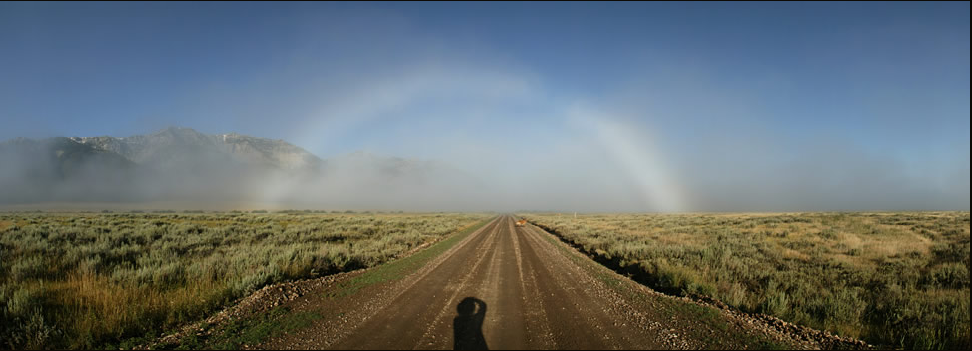Montana Fogbow
Montana Fogbow: A Spectral Phenomenon in the Centennial Valley Red Rock Lakes Wildlife Refuge
Have you ever witnessed a ghostly and ethereal fogbow? If not, then the Montana Fogbow is a spectacle that you wouldn't want to miss. Unlike its vibrant counterpart, the rainbow, the Montana Fogbow is created by tiny mist droplets rather than large raindrops. It is a fascinating atmospheric optics phenomenon that occurs in the remote Centennial Valley Red Rock Lakes Wildlife Refuge in Montana. Let's dive deeper into the captivating features and intricacies of the Montana Fogbow.
When a fogbow appears, the shadow of the photographer's head can be seen at the center of the bow, known as the antisolar point. This point is directly opposite the position of the sun. The fogbow's distinctive appearance includes a dark band just inside the bow, followed by a faint and broad supernumerary. Similar to a rainbow, the area inside the bow is illuminated with refracted and reflected light, creating a bright and captivating display.
Here are some key features and characteristics of the Montana Fogbow:
-
Size Comparison: Unlike rainbows, fogbows are formed by smaller mist droplets instead of larger raindrops. This size difference contributes to the ghostly appearance of the fogbow.
-
Antisolar Point: The shadow of the photographer's head acts as a marker for the antisolar point, which is located at the center of the fogbow. This point is directly opposite the position of the sun in the sky.
-
Dark Band: Inside the fogbow, there is a distinct dark band. This band adds to the unique visual appeal of the phenomenon.
-
Supernumerary: Following the dark band, a faint and broad supernumerary can be observed. This additional feature enhances the overall beauty of the fogbow.
-
Brightness: Similar to rainbows, the area inside the fogbow is bright due to the refraction and reflection of light. This creates a captivating contrast against the surrounding atmospheric conditions.
-
Secondary Fogbow: Occasionally, a fragment of a very faint secondary fogbow can be observed outside the primary fogbow. This secondary bow adds an extra layer of enchantment to the already mesmerizing display.
Now that we have explored the unique features of the Montana Fogbow, let's delve into the scientific explanation behind this captivating atmospheric phenomenon.
The formation of a fogbow is closely linked to the interaction of light with water droplets suspended in the air. When sunlight passes through these tiny droplets, it undergoes a process known as refraction. Refraction causes the light to bend and separate into its component colors, forming a circular arc. In the case of fogbows, the droplets are smaller and more numerous than raindrops, resulting in a diffused and less vibrant display compared to rainbows.
To fully appreciate the Montana Fogbow, it is important to understand its connection to other atmospheric optical phenomena. Fogbows share similarities with rainbows, but their distinct characteristics set them apart. Here are some key differences between fogbows and rainbows:
- Droplet Size: Fogbows are formed by smaller mist droplets, while rainbows are created by larger raindrops.
- Intensity: Rainbows are typically more vibrant and colorful, while fogbows have a ghostly and ethereal appearance.
- Visibility: Fogbows are more commonly observed in foggy or misty conditions, whereas rainbows are visible after rain showers.
- Secondary Bow: While both fogbows and rainbows can exhibit a secondary bow, it is often fainter and less prominent in fogbows.
The Centennial Valley Red Rock Lakes Wildlife Refuge in Montana provides an ideal setting for witnessing the captivating Montana Fogbow. The remote and pristine environment allows for optimal conditions, ensuring that the fogbow can be observed in all its glory.
Next time you find yourself in the Centennial Valley Red Rock Lakes Wildlife Refuge on a misty day, keep an eye out for the elusive Montana Fogbow. Its ghostly beauty and unique characteristics make it a mesmerizing spectacle worth experiencing firsthand. Embrace the wonders of atmospheric optics and let the Montana Fogbow leave you in awe of the natural world around us.

Montana Fogbow imaged by James Perdue (Photography) in the remote Centennial Valley Red Rock Lakes Wildlife Refuge. Image ©James Perdue, shown with permission.
The ghostly fogbow is produced by small mist droplets compared to the large raindops that make its the colourful rainbow counterpart. The shadow of the photographer's head marks the bow centre at the antisolar point directly opposite the sun. Just inside the bow is a characteristic dark band and then a faint and broad supernumerary. Like a rainbow, the area inside the bow is bright with refracted and reflected light. Outside the bow to the right there is a fragment of very faint secondary fogbow.
Note: this article has been automatically converted from the old site and may not appear as intended. You can find the original article here.
Reference Atmospheric Optics
If you use any of the definitions, information, or data presented on Atmospheric Optics, please copy the link or reference below to properly credit us as the reference source. Thank you!
-
<a href="https://atoptics.co.uk/blog/montana-fogbow-2/">Montana Fogbow</a>
-
"Montana Fogbow". Atmospheric Optics. Accessed on April 24, 2024. https://atoptics.co.uk/blog/montana-fogbow-2/.
-
"Montana Fogbow". Atmospheric Optics, https://atoptics.co.uk/blog/montana-fogbow-2/. Accessed 24 April, 2024
-
Montana Fogbow. Atmospheric Optics. Retrieved from https://atoptics.co.uk/blog/montana-fogbow-2/.